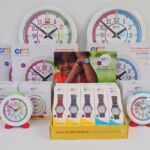
Are you struggling with how to tell the time as an adult? Whether you have always struggled with telling time or you want to improve your time-telling abilities, then our resources are here to help you master this essential skill. We understand the importance of clear and simple time-telling methods, and our range of time-teaching watches, clocks, and innovative aids are designed specifically to help adults learn how to tell the time.
How to Tell the Time as An Adult
Learning to tell the time can be a daunting task, especially for adults who may have missed out on mastering this skill during their childhood years. Here at EasyRead Time Teacher, our team recognises this need and offers a range of specialist resources designed to support adult learners. Whether you prefer a traditional clock, a stylish watch, or interactive games and aids, EasyRead Time Teacher has you covered.
Clocks
Our EasyRead clocks are the perfect addition to any kitchen, office, or living room, and with their sleek design and range of colours, our clocks blend into any interior decor. So, whether you prefer a classic white clock or a vibrant red one, there is a clock to suit your personal taste, and with their silent sweep motion there is no distracting ticking sound, allowing you to focus on telling the time without any unnecessary noise.
The unique design of the clock contains all the information you need, ensuring that you can easily read the time at a glance. The large, clear numbers on the dial make it easy for adults to distinguish between the hours and minutes, eliminating any confusion that may arise from more complex clock designs, and our clocks are available with either the ‘minutes past and to’ or ’12 /24 hour’ method, depending upon which method you are most comfortable or familiar with.
Explore our range of wall clocks and alarm clocks and pick the best option for your unique requirements.
Watches
For adults who prefer a more portable time-telling solution, our EasyRead watches are the perfect choice. Available in a wide range of colours, with the option of a fully waterproof model, EasyRead has a practical and stylish watch to suit every individual’s taste and requirements. With easy-to-use, adjustable straps, you can adjust the strap to fit your wrist comfortably, and swap them for different colours depending upon your outfit. The straps are also easily changed, allowing you to switch between different colours and patterns to match your mood or outfit, and with up to medium adult size, these watches provide a comfortable fit for most individuals.
The watch face itself is designed with simplicity and clarity in mind. The large, bold numbers make it easy to distinguish between the hours and minutes, ensuring that you can accurately read the time, and the clear labelling of “past” and “to” also helps adults understand the concept of time progression, making it easier to interpret the exact time displayed on the watch.
Master this essential life skill with our range of EasyRead watches.
Games & Aids
Sometimes, a little extra practice and reinforcement can go a long way in learning how to tell the time as an adult. We offer a range of interactive resources, games and aids, that are specifically designed to make the learning process fun and engaging to help reinforce your understanding of time-telling concepts and improve your overall proficiency.
One of our most popular games is the Tell The Time Card Game, which combines the fun of a traditional card game with the educational aspect of learning to tell the time. These cards can be used to play various games including snap, matching pairs, and bingo, so you can get the whole family involved. Each pack contains 60 playing cards showing the different times of day and by matching the digital and analogue times on the cards, players can improve their ability to read and interpret different time formats, making them a versatile tool for adult learners.
In addition to our Tell The Time Card Games, we also offer TwinTime Cards to support adults in their time-telling journey. These aids are a hands-on, double-sided teaching resource that features a Past & To dial on one side and a 24-hour time dial on the other side, with moveable hands on both sides. These cards are made from wipeable PVC and have a space below to write the time displayed on the clock, designed to provide additional practice and reinforcement and are also a great tool for practising fractions and counting backwards if this is an area in which you could benefit from additional practice or support.
We understand that every individual learns how to tell the time differently, which is why our games and aids cater to various learning styles. The visual nature of these aids helps adults develop a stronger understanding of time-telling concepts and enhances their ability to read and interpret different clock formats, so no matter your preferred method of learning, there is an EasyRead game or aid that can help you on your time-telling journey.
Explore our range of games, aids, and resources today.
Learn How to Tell the Time with EasyRead Time Teacher
Learning how to tell the time as an adult does not have to be a complex or daunting task. With our range of specialist resources, you can confidently improve your time-telling abilities and master this essential skill with the tools you need to succeed, so embrace the simplicity and clarity of our innovative solutions today.

It has been recently revealed that many primary school children are behind in terms of maths ability and learning, with young children often being weeks behind pre-lockdown norms. So, what can we do to support teachers and children in the classroom? Our innovative and effective time teaching resources are specifically designed to engage and empower students and support their maths learning. We aim to make the learning process both enjoyable and easy-to-understand, and with our comprehensive collection of materials, primary school children can easily explore important maths concepts and develop a clear understanding of maths. From interactive games and worksheets to engaging activities and real-life examples, our time teaching resources provide a well-rounded approach to maths learning, so read on to explore our time teaching resources.
The Importance of Maths
A good, working understanding of key mathematical concepts, and their relevance to day-to-day life is a crucial aspect of a child’s education. This understanding is not just important for academic success and basic addition – it also helps them develop problem-solving skills and enhances their critical thinking abilities. From managing finances to interpreting data, maths is an integral part of everyday life, and it is essential for children to have a solid understanding of maths from an early age.
From a young age, children are exposed to numbers and basic mathematical concepts, such as telling the time – but as they progress through primary school, the complexity of maths increases and it becomes necessary to provide them with additional tools, resources, and clear demonstrations to support their learning. However, since the outbreak of the Coronavirus and the subsequent lockdowns, children of all ages have not had access to the hands-on learning process, and the resources that they need to develop their maths abilities.
The COVID-19 pandemic has disrupted education in various ways, and one of the areas that has been the most affected is maths learning. A recent report by the Education Policy Institute has highlighted how much primary school pupils are struggling with maths post-COVID. The report reveals a growing mathematical skills gap in the wake of the pandemic, with primary school children being 5 weeks behind in their learning when compared to expectations prior to the outbreak.
This report, hailed as a ‘wakeup call’ for politicians and policymakers alike, demonstrates that education recovery after the pandemic is not achieving the results that it needs to ensure every child is learning at the required level. The lack of in-person interaction over lockdown has greatly impacted this, as maths often requires hands-on activities and collaborative learning, and the absence of regular classroom routines and face-to-face teaching has made it difficult for children to grasp new concepts and receive immediate feedback. Finally, even if all of these factors weren’t an issue, many children lacked access to technology or struggled with the transition to virtual learning environments, putting them at even more of a disadvantage.
How Our Time Teaching Resources Can Help
At EasyRead, we understand the importance of providing effective tools to support maths learning, particularly with the nationwide push to get primary school learning back on track.
Our time teaching resources are designed to engage students and facilitate their understanding of important mathematical concepts. With a range of interactive games, worksheets, activities, and real-life examples, our resources offer a comprehensive approach to teaching maths. So, let’s explore our range of time teaching resources.
EasyRead Classroom Clocks
One of our key time teaching resources is the EasyRead Classroom Clock. This specially designed clock incorporates unique features that make it easier for children to learn and understand the concept of time, including:
⦁ A large, clear face that divides the hour into simple segments, allowing children to easily distinguish between minutes and hours.
⦁ The minute hand is longer and thinner, while the hour hand is shorter and thicker, and both hands move within a clearly designated ring, making it easy for children to read the time accurately.
⦁ Available with either the 12/24 Hour or Past & Two teaching method, depending upon the requirements of each school.
By using the Easy Read clock in the classroom, teachers can actively engage students in learning about time. The clock’s design encourages hands-on interaction and enables children to practise reading analogue time independently, as well as making it much easier for them to confidently recognise numbers. This resource not only enhances their mathematical skills but also cultivates a sense of time management and punctuality, and helps pupils to apply their new skills to their day to day lives by using the clock to observe the passage of time during a lesson or to see for themselves how much time is left until the end of the day.
EasyRead TwinTime Cards
In addition to the classroom clock, our EasyRead TwinTime Cards provide another valuable resource for supporting maths learning. These cards feature a unique double-sided design that allows children to practise both analogue and digital time and helps them make connections between the two.
By using these cards in the classroom, teachers can create engaging activities and games that promote active participation and consolidate pupils’ understanding of time. Either use the cards with the classroom clock, or Teacher Cards, by asking them to write the time down on their cards, or pair the pupils up and encourage them to interact with each other and support each other’s learning through play.
Our cards are also excellent for introducing further mathematical concepts, such as addition, subtraction, and fractions: simply use our cards to count forwards and backwards from 30, count in multiples of 5s and 10s, and discuss how the clock face can be divided into fractions in the form of half an hour, a quarter of an hour, and 10 minutes.
EasyRead Tell the Time Card Games
Our Tell the Time Cards build upon the skills learnt through our clocks and games, and focus in more detail on specific time concepts, such as quarter past, half past, and quarter to the hour.
Each card presents a visual representation of the time, allowing children to practise reading and interpreting different times through familiar games such as snap, matching pairs, buddy-up, and bingo. By incorporating these cards into classroom activities, teachers can create hands-on opportunities for students to explore different time scenarios and strengthen their time-telling skills.
Easy Read Classroom Sets
To provide a comprehensive maths learning experience, we also offer EasyRead Classroom Sets. These sets include a combination of classroom clocks, TwinTime cards, and tell the time cards, providing teachers with a complete toolkit for supporting students’ mathematical development.
By using the classroom sets, teachers can create a dynamic learning environment that caters to different learning styles and abilities. The combination of visual and interactive resources in the sets ensures that all children have access to effective tools for understanding and mastering time concepts, and creates a collaborative learning environment for all pupils to develop their own skills and support their classmates.
Choosing the Right Time Teaching Resources
Selecting the right time teaching resources for your students is crucial to their maths learning journey. When choosing from our range of resources, it is essential to consider the specific needs and abilities of your students by assessing their current level of understanding and identifying any areas where they require additional support. This is more important than ever in light of the recent reporting around the current mathematical skills gap in UK primary schools.
If your students are just beginning to learn about time, then our Classroom Clock is an excellent introduction to telling time. The clock provides a visual and interactive approach to time learning, and is always available on the wall for pupils to engage with and practise their new skills.
Once the students have built up a familiarity with the core concept of time and a basic understanding of how to tell time on their own, then our cards are an excellent way to consolidate their skills. They are also an excellent choice for students who are more advanced and need reinforcement in specific time concepts, and cater to different learning styles and abilities, ensuring that every student has the opportunity to succeed in learning how to tell the time.
Supporting Pupils and Teachers with Our Time Teaching Resources
The challenges in maths learning post-COVID highlight the need for effective resources to support students in their mathematical development, and our time teaching resources offer a range of innovative and engaging materials designed to create a comprehensive approach to teaching and learning.
Explore our full range today to find the perfect resources to bridge the gap in maths ability and promote a hands-on approach to telling time in your classroom.
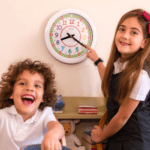
Are you or your little ones having trouble with how to tell the time on a clock with hands? With screens and digital devices dominating our daily lives, it’s no surprise that analogue clocks can be confusing in the digital age. It’s not uncommon for children to feel confused and frustrated by analogue clocks, and for learning how to tell the time to become a daunting task. That’s why, at EasyRead Time Teacher, we offer a range of clocks, watches, and fun games designed to make learning to read analogue clocks much easier for children and adults alike.
Analogue time-telling challenges
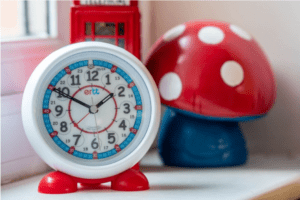
In today’s digital age, children and adults are surrounded by screens and digital devices that display time in a digital format. The unfamiliarity with analogue clocks can lead to confusion and frustration, making it difficult for children to grasp the concept of time once they begin to learn how to tell the time in nursery or primary school. Any confusion or challenges children face can be made worse if their parents experience confusion when using an analogue clock. As many adults rely solely on their phones to tell the time, and don’t often use analogue clocks, it can be confusing for them to return to analogue clocks to support their children’s learning. As a result, the concept of reading time on a traditional clock with hands can be a challenge, but it remains an essential life skill.
The most common, and potentially the most confusing, challenge that children face when learning how to tell time is the use of numbers and divisions on the clock face. Unlike digital clocks that display the time in a clear, straightforward manner, analogue clocks require children to tell the time themselves. Digital clocks show only the time, and don’t contain any additional numbers that can cause confusion, whereas analogue clocks require children to interpret the position of the hands in relation to the numbers on the clock face. This can be a cognitive hurdle for many children, as it requires spatial reasoning and the ability to mentally divide the clock face into segments.
Another complex challenge children face when reading the time is understanding the relationship between the hour and minute hands. The varying lengths of the hands and their distinct movements can be confusing, especially for young children. It can also be hard for them to identify which hand is which, as the majority of clock designs contain hands of the same colour which can cause the hands to appear as similar lengths to each other. Additionally, the minute hand’s continuous movement can be overwhelming, making it hard for children to determine the exact time, particularly if the hand moves gradually rather than jumping between the minutes.
The digital age has undoubtedly played a role in exacerbating these challenges. Children are constantly exposed to digital clocks on their electronic devices, which provide an instant and precise representation of time. However, this reduces an understanding of time to four simple numbers on a screen, rather than requiring a working understanding of the passage of time and how the key components of a clock work together to demonstrate the time. This stark contrast to analogue clocks can make it difficult for children to understand why analogue clocks are still relevant and necessary to learn.
Overcoming time-telling struggles with our clocks

We offer a range of innovative clocks specifically designed to help children and adults overcome their struggles with reading analogue time, and these are useful resources that can be used by the whole family. Our wall clocks and alarm clocks feature a unique design and a combination of design elements that simplify the process of telling time, making it more accessible and less daunting to learn how to tell the time.
Clear numbers
One of the key features of our clocks is the clear and distinct labelling of the hour and minute sections of the clock. There are two key sections of the clock, with an inner ring showing the hours, with the hour hand clearly embedded within this ring to clearly show the time. The second, larger ring runs around the edge of the clock, and breaks up each minute into clear sections. This separation between the different hands helps children and adults differentiate between the two and makes it easy to visualise and understand their respective functions.
Past and to design
Our EasyRead clocks also feature a unique “minutes past” and “minutes to” design at the centre of the clock face. Instead of relying solely on numbers, these clocks use the phrases “minutes past” and “minutes to” to indicate the time. This approach helps children understand the concept of time progression and the relationship between hours and minutes. Subtle markers for the quarter hours, as well as an “o’clock” reminder at the top of the face, complete this comprehensively scaffolded design.
By using phrases rather than numbers, children can develop a more intuitive understanding of time and its progression, making it easier for them to articulate the passage of time rather than simply reading numbers that they may not fully understand. As well as the “minutes past & to” method, our clocks are available with the “12/24” hour option as well, depending on the preferences of your child, yourself, or the whole household. These designs include all 60 minutes of each hour, and the 24 hours of the day rather than the initial 12 on our “past & to” designs.
Time teaching
Our clocks come with a step-by-step teaching method that gradually introduces children to different aspects of reading time. The clocks include a detailed instruction manual that guides parents and teachers on how to tell the time, helping parents to effectively teach children to read analogue time. The step-by-step approach ensures that users of our clocks can build their time-telling skills progressively, leading to improved confidence and accuracy.
Improving time-telling skills with our watches

In addition to our wall clocks and alarm clocks, we also offer watches designed to further enhance users’ time-telling skills by serving as an opportunity, and a constant reminder, to practise reading analogue time in real-life situations. Available with either the “minutes to & past” method or our 24-hour clock designs, our watches are designed to accommodate the method that your child, or yourself if you are keen to improve your analogue time-telling abilities, prefers.
Our watches, like our clocks, are designed with clarity and simplicity in mind, and our watches feature the same innovative design elements as our clocks, making it easier for children to transfer their time-telling skills. This consistency in learning and practising makes it easier to implement long-term recall and for users to practise their new skills wherever they are. By regularly using their watch to track the passing time, children can learn to manage their daily activities and develop their time management skills. This skill becomes especially valuable as they grow older and face more structured schedules and time-bound tasks.
Whatever your child’s style preferences or lifestyle requirements, our range of watches will have the perfect solution. As well as offering the time-telling method that best suits your requirements, our watches also come water-resistant as standard with the option for a fully waterproof watch for users who spend the majority of their time outdoors or engaging in physical activity. Choose the time-telling method of their choice and pair with a watch strap in their favourite colour, or our camo option, for a personalised, stylish daily accessory that encourages your child to actively read analogue time.
Making time-telling fun with our games and resources

Here at EasyRead Time Teacher, we believe that learning should be a fun and interactive experience. That’s why we offer specially-designed time teaching games and resources that go hand in hand with our clocks and watches, making time-telling an enjoyable activity for users of all ages.
As well as the EasyRead leaflet that comes with our clocks to introduce the time-telling methods we offer, our tell-the-time card games are one of our most useful and engaging resources. The card games allow children, and members of the whole family, to practise their time-telling skills at their own pace at home. The concept of the games is to reinforce understanding through repetition, and the game can be repeated as many times as needed thanks to the 60 playing cards showing 15 different times of day.
By creating an association with family time and an engaging game, our cards keep children motivated and interested in learning, as well as making telling the time an interesting challenge, rather than a tedious lesson. We take the outdated methods of teaching children how to tell the time and remodel them to suit the requirements of 21st century learning, as well as framing the concept of time in an accessible, easy-to-follow way. By bridging the gap between school, home, and free time, our resources ensure a comprehensive approach to telling time, and encourage users of all ages to develop their time-telling skills and gain a deeper understanding of time and its relevance in our daily lives.
Overcome how to tell the time struggles with EasyRead

Learning to tell the time on a clock with hands may seem like a challenging task in today’s digital age, but with the help of our clocks, watches and games, children and users of all ages can overcome these struggles with how to tell the time and develop a strong understanding of an analogue clock.
By simplifying the process and making it enjoyable and accessible, our resources empower our users to confidently read time and develop essential time management skills that will benefit them for a lifetime. So, explore our full range today and find the perfect EasyRead support system for your little ones’ learning.

As students up and down the country return to school after Easter, now is the perfect time to stock up on the latest and best teaching materials for your classroom. As an educator, you know how important it is to have the right tools to help your students learn and stay on track, and with a variety of specialist designs and colours to choose from, our teaching time clocks are perfect for any classroom or teaching style. Our classroom resources, including playground clocks and card game resources, are perfect for daily use in a classroom and ensure that you have a consistent approach to teaching time. So, get ready for the new term with confidence and ease, and let our range of time-teaching products do the hard work for you.
Time Teaching Clocks
If you are planning on introducing your pupils to the concept of time this term, or building on their existing time-telling skills, then our time teaching clocks are an excellent resource for your classroom wall. Our clocks are specially designed to contain all the information that a child needs to learn how to tell the time, with easy-to-read numbers and colour-coded segments to ensure every student can access the resource from any part of the room.
View our full range of teaching time clocks here.
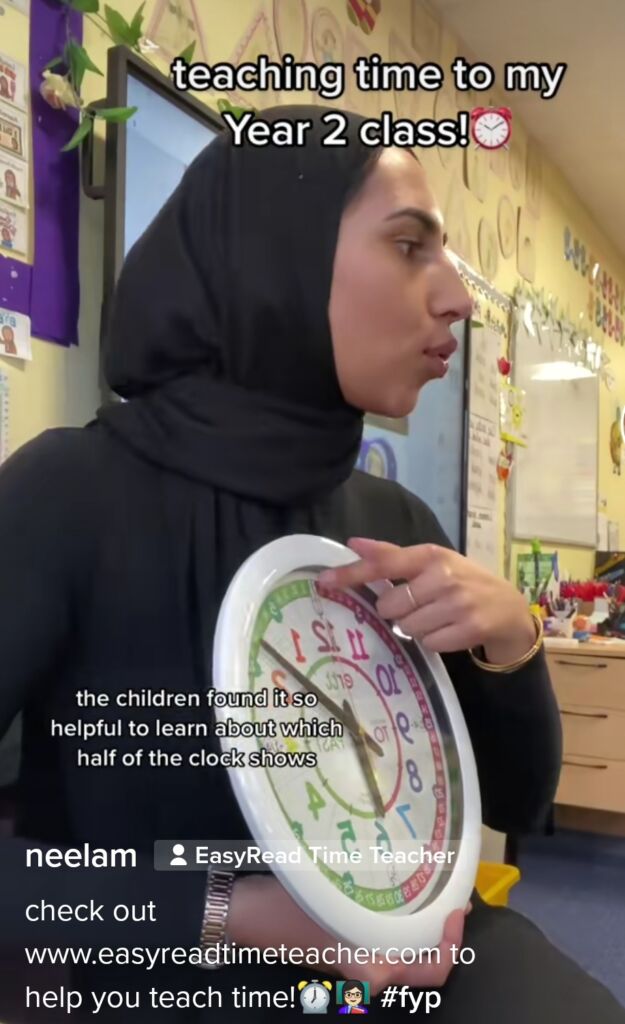
“The children found it so helpful to learn about which half of the clock shows past and quarter, including all the different intervals, because it is colour-coded! They also have these really cool children’s watches, which have the exact same face as the teaching clock, so I will definitely be putting this up in my classroom!”
@ nrashid_x
Twin Time Cards
Our TwinTime Student Cards offer an excellent and engaging opportunity for pupils to practise telling the time. Each card can be used individually, for a more formal test, or in groups to encourage pupils to support each other and are also an effective resource for introducing students to elements of the primary school numeracy curriculum. The cards are designed to be durable and long-lasting, as well as easy to maintain, with a high-gloss, write-on wipe-off PVC sheet, and ample room for the students to fill in the time displayed on the clock.
View our TwinTime Student Cards here.
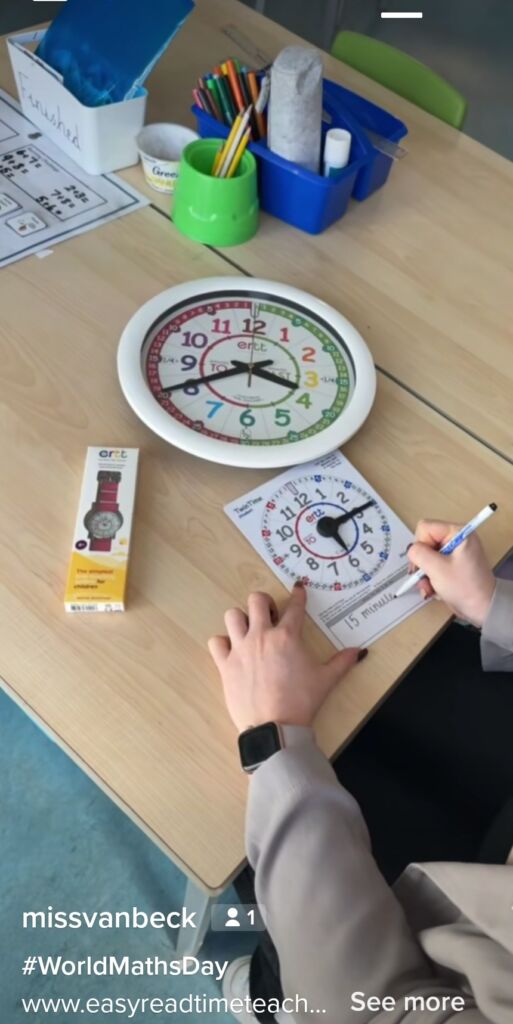
“Easy Read Time Teacher has this amazing wall clock which I just absolutely love: it splits up the concept of time really simply and it’s a great visual for children to use. And I just love the student teaching aid that they can write on with whiteboard pens. I love the durability of this and it’s great for working through problems with children one-to-one.”
@ missvanbeck
Watches
Our EasyRead wrist watches come with the same clear face designs and teaching methods as our clocks, for a consistent and comprehensive approach to teaching time. Whilst many of your pupils will no doubt already have their own watches, having a designated classroom watch offers many opportunities for pupils to practise their time-telling abilities. For example, the pupils can take it in turns to be the class Time Monitor, who keeps track of their daily routine, or who the other students can ask to tell them the time, creating an engaging and practical time-telling environment that encourages all pupils to participate.
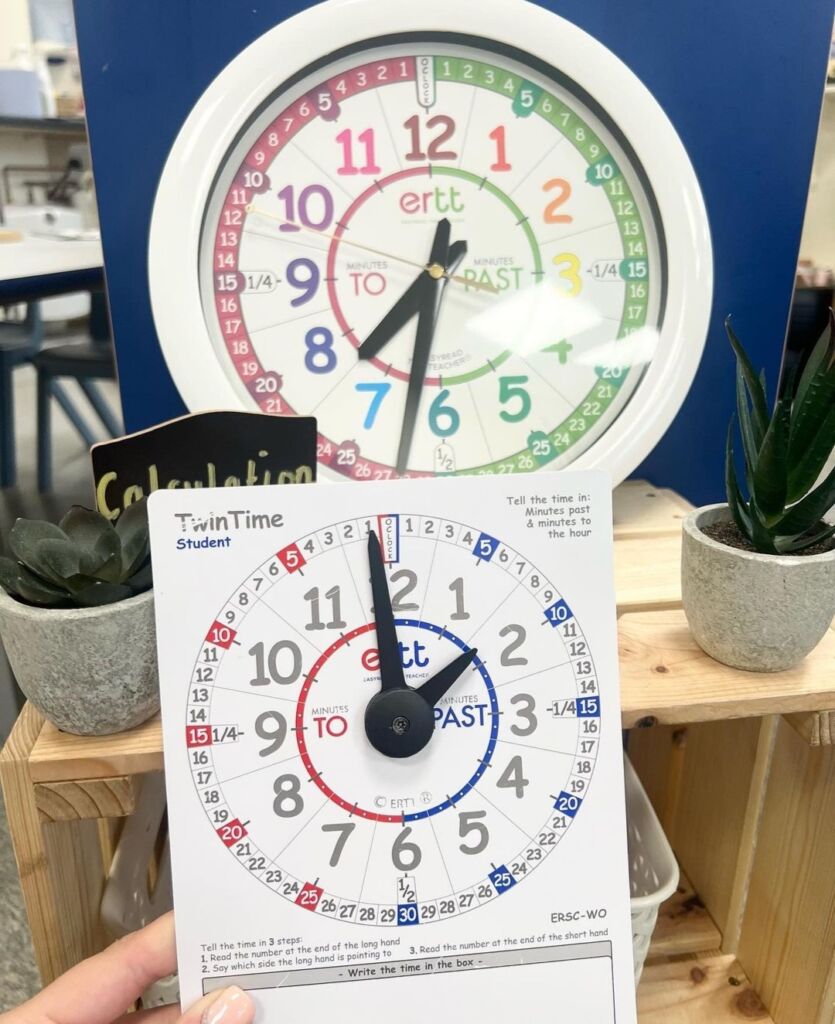
“Telling the time is a fundamental skill, and it’s so important to get the teaching of time right (..) I can’t wait to teach time, so I can use some of the great resources provided by EasyReadTimeTeacher. I can’t wait to have a time monitor, so that the children can all have a turn wearing the watch. I think they will love using it to tell the time.”
@ misscsclassroom92
Playground Clocks
Our range of Playground Clocks feature similar face designs to our classroom clocks and watches, reinforcing their learning with uniform designs that contain all the information they need to practise telling the time during breaks. The durable and reliable weatherproof clock can be used anywhere in the school, including outdoor spaces such as playgrounds, gardens and school entrances. The powder-coated steel frame with toughened glass ensures durability and longevity and is designed to withstand harsh weather conditions, making our playground clocks a worthwhile investment in your students as they learn to tell the time themselves.
Stock up on Classroom Resources for this term
Now is the perfect time to stock up on the latest and best classroom resources for your class. Our range of classroom resources, including clocks and card games, are perfect for daily use in a classroom and ensure that you have a consistent approach to teaching time.
Find the right resource for your pupils and your classroom, or explore our range of resources for use at home, in our full range of time teaching products.
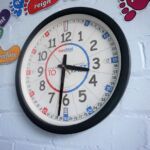
Whether you are introducing time as a concept to young children, or making sure that your students can understand time through real-world examples, learning clocks are an excellent time-teaching tool. Learning clocks not only help children tell the time, but are also an effective way to introduce maths concepts such as fractions, addition and subtraction.
If you are searching for useful resources and practical tips to make the most of the learning clocks in your classroom, read on.
Time teaching
Our colourful, engaging classroom learning clocks are an excellent tool for introducing the concept of time to students. These clocks are designed to include all the information that a child needs to learn to tell time, including clearly-marked minutes, ten-minute blocks, and ‘past/to’ indicators. These straightforward visuals make it easier for children to understand and engage with the concept of time, and these time-telling skills can subsequently be applied to many mathematical activities. This can include addition and subtraction, as pupils can use the clock to add and subtract by counting minutes and hours. For example, if it is currently 10 past the hour, you can ask the children to add five minutes, which is easily achieved on our clocks.
Link to the curriculum
Our learning clocks come with curriculum notes printed on the back, making it easier for you to deliver a detailed and accessible time-telling demonstration that is linked to the curriculum. This ensures that you are teaching your students time in a way that is consistent with the expectations of their education.
The school day
Another effective way to use our learning clocks in the classroom is to link time-telling activities to the school day. Young children are more likely to engage with a concept if they can see how it relates to their own experiences, and using the clock to demonstrate their own timetable is an effective time-teaching strategy. This can be done by demonstrating when lunchtime, breaktime, or lessons begin and end, as well as encouraging them to tell the time of these scheduled activities themselves.
Pair with games
Using learning clocks as part of an educational game is another effective way to engage your students and in learning to tell time. Our TwinTime cards are perfect for this, as you set a time and ask your pupils to replicate it on their own cards, with space for them to also write in the analogue or digital time.
There are several different ways to make this game more engaging and challenging, including having the pupils work in pairs or small groups to see who can replicate the time the fastest, or who can get the most correct answers in a set amount of time. This makes the challenge of learning to tell the time a collaborative and engaging activity that can be shared with friends.
Support students with dyscalculia
For students with dyscalculia, learning to tell the time can be particularly challenging. If you have pupils with dyscalculia in your classroom, then our learning clocks are an excellent resource to support these students with minimal differentiation. The colourful, clear designs of our clocks break down the concept of time into a straightforward pattern that makes it much easier for children with dyspraxia to engage with time and numbers.
Once your students are comfortable with the basics, you can start to introduce more complex concepts, such as fractions and time zones, with our accessible designs. To support students with dyscalculia, it’s important to be patient and to provide plenty of opportunities for practice and reinforcement, which is made easy with our range of classroom resources.
Conclusion
By linking the clock to the curriculum, incorporating the students timetables, pairing it with games, and supporting students with dyscalculia, you can ensure that your students learn to tell the time in a fun and interactive way. By utilising a learning clock in your classroom, your students can develop their time-telling skills while also engaging in teamwork, friendly competition, physical activity, and memory improvement.
Why not try using learning clocks in your classroom today and see the difference they can make for your students.
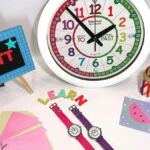
Learning how to tell the time can be a challenge for any child, or adult for that matter. As well as being a requirement as part of the primary curriculum, being able to identify time and understand time as a concept is an important part of a child’s development and growth. For those who have dyscalculia, learning how to tell the time is even more challenging, and often requires special accommodations or teaching techniques. It is often hard for parents and caregivers to know how to help a child with dyscalculia learn to tell the time, as the child will engage with clocks and numbers in a different way. Time teaching resources, such as our clocks, games and aids, can make a real difference to their learning, as well as supporting adults with dyscalculia.
What is Dyscalculia?
Dyscalculia is often referred to as ‘mathematical dyslexia’, and is a condition that involves difficulty with numbers or mathematics. The most common symptoms of dyscalculia include difficulty performing calculations, counting backwards and understanding place value, as well as weak overall mental arithmetic skills and difficulty remembering basic mathematical facts.
For those with dyscalculia, many daily activities involving numbers become difficult, such as addition and subtraction, paying for goods with cash, and telling the time. There are several practical ways that parents can help a child who struggles to tell the time due to dyscalculia, and one of the most effective is to invest in teaching products and techniques to use at home and in the classroom.
Many of these products can also support adults with dyscalculia who may struggle to tell time, as they are designed to simplify the timetelling process for people of all ages.
How to help a child with dyscalculia
If your child has dyscalculia, or is demonstrating symptoms of dyscalculia, or you yourself require assistance, then our time telling range offers fun and useful assistance in learning how to tell the time.
Clocks
For many children with dyscalculia, the hand placement and basic design of analogue clocks can be very confusing. On almost every clock, there are only 12 numbers, meaning that up to 80% of the information needed to learn how to tell the time is missing. This places those with dyscalculia at an extreme disadvantage and makes telling time a difficult task for people of all ages. Our EasyRead clocks include a clear breakdown of all 60 minutes and can be read in 3 simple steps that can be learnt quickly and memorised for a lifetime, supporting those with dyscalculia from childhood to adulthood.
This will be particularly effective when teaching your child how to recognise numbers that are close to the hour. For many children with dyscalculia, 7:55 and 8:05 will be almost identical to 8:00, so our clocks reduce the confusion around these numbers and will make learning digital time much easier later on.
Our clocks also feature bold and colourful designs and easy to read numbers to encourage engagement. Visual models, as well as engaging designs, break down the wider concept of time and make it much more accessible and easier for people with dyspraxia to tell time by combining numbers and colours in straightforward systems.
Games and Aids
Educational and fun activities are always an effective learning tool, and children with dyscalculia respond particularly well to objects and games that make time telling simple and engaging rather than complicated. Our games encourage children to interact with time and numbers outside of the clock and makes learning time fun and engaging for anyone at any age!
Our games make the challenge of telling time rewarding, rather than daunting, and can be enjoyed during family time or playtime. Many children with dyscalculia often feel confused or embarrassed when learning to tell the time, particularly in school, and our games are a low-stakes alternative to tests or worksheets. If you yourself have dyscalculia, then these games will be an effective and fun way to improve your own time telling abilities whilst supporting your child.
Finding the perfect clock
When teaching young children with dyscalculia to tell the time, or interacting with an adult with dyscalculia, the best resource you can use is a positive and patient mindset. Finding a strategy and resources that work for your child will encourage them to tackle new challenges and boost their confidence when it comes to completing other number-related activities.
To find out more about the features and benefits of our EasyRead clocks, or to discover your preferred time teaching method, please click here.

We’re living in an increasingly digital world and yet children are still expected to learn to tell the time on an analog clock as part of the primary curriculum. If you rely on your phone, computer screen, or smartwatch to know what time it is, that’s understandable, but in order to help your child learn it’s a good idea to start putting some analog clocks around your home. One great way to support your child’s learning is by putting a clock in their bedroom. Time teaching resources such as our children’s bedside clock can really make a difference to their understanding, and of course, help them to appreciate when is an acceptable time to get out of bed!
The concept of time
Ok, so we may have overexaggerated on the getting out of bed thing. We appreciate that young children are just too excited to start their day to worry about whether the adults have had enough sleep, but that said, having a clock your child can refer to when they wake is the start of building an understanding about the concept of time.
Interactive learning
A child’s alarm clock also has the benefit of being interactive. Not only can they look at the hour and minute hands and large numbers to try to put the elements of time together, but they can also use the button to set and unset the alarm.
Not just an alarm clock!
Our clocks also double as a night light with their built-in LED lighting, so if little ones don’t like sleeping in the dark, they can rely on the gentle glow from their bedside clock to provide some reassuring light.
Improve the bedtime routine
You can use an alarm clock to help a child understand their bedtime routine. For example, you can clearly point out when it is time to brush their teeth or get into bed. This helps them to associate certain routines with particular times of day, and then see what they look like on the clock. As they become more confident, you can ask them to let you know when it’s time to grab their toothbrush or get dressed ready for bed.
What to look for in a child’s alarm clock
For young children who are just starting to learn to tell the time at school, an alarm clock with bold, bright colours and easy to read numbers will be most helpful. Our children’s bedside clocks have been designed with either our ‘past and to’ or ‘12/24 hour’ time teaching method, both of which feature bold colourful numbers for each hour and a clear breakdown of the minutes, to help support what children are learning in the classroom.
Another important feature to look out for is silent hands. Kids don’t need much of an excuse to avoid going to sleep, so putting an alarm clock with a noisy ticking sound next to their bed could be fuelling their night time restlessness. We much prefer a silent clock, which is why we’ve designed our children’s alarm clocks with silent sweeping hands.
For parents of little sleepy heads, the crescendo alarm is a popular feature as it starts off with a gentle beep and gets louder until it is turned off.
To find out more about the features and benefits of our children’s bedside clocks or to choose your preferred time teaching method and colour, please click here.
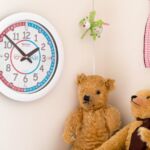
Whether you’re a parent trying to support your child in their learning, a grandparent looking for an educational gift or a teacher sourcing the best resources to use in the classroom, you’re in the right place to find the perfect clock for teaching time. With many different products available, we’re here, as parents with experience of the time teaching struggle, to show you what features you need to consider when buying a clock to help your child learn this vital skill.
The best size clock for teaching time
We’re firm believers that there isn’t one size that fits all as some children will prefer to see a clock on the wall when learning to tell the time, whereas others will prefer a watch on their wrist to practise on the go. However, if you are looking for a teaching time clock for your walls at home or in the classroom, we believe our clocks are perfectly proportioned!
Wall Clocks – Our wall clocks are ideal for use at home – in bedrooms, nurseries, playrooms and kitchens. With a diameter of 29cm they are the perfect size to be seen across the room, without taking up too much space.
Classroom Clocks – our classroom clocks are a larger version of our popular wall clocks and have been upscaled to a diameter of 35cm to enable them to be seen by students across the classroom. With an ergonomic hanger and curriculum notes printed on the back of the clock, they are a really helpful resource for demonstrating time teaching in the classroom.
Alarm Clocks – our alarm clocks are a great bedside companion for helping children practise telling the time before they go to bed and when they wake up. At just 12.5cm in diameter, these clocks are small enough to easily fit on a bedside table or nearby shelf and feature a built-in night light to add gentle glow to your child’s room.
Outdoor Clocks – our wall clock design has been supersized and strengthened to create an outdoor clock which enables you to take the time teaching outside – at school, on the farm, at an activity centre or in the garden. Whether you use it as part of an outdoor lesson on a sunny school day, or place it where children can use it to practise their own time telling abilities, this 38cm diameter black and white weatherproof clock is definitely up to the job.
A clear and easy to read face
As with anything that is trying to impart wisdom and knowledge, the information should be clear and easy to read and we took these key principles on board when designing our time teaching clocks. Born from the struggles we’ve had as parents getting our own children to learn to tell the time, our clocks feature either our 2-step ‘12 & 24 hour’ or our 3-step ‘past and to’ time teaching systems. Each system is simple to grasp and with the colourful, bold designs of our clock faces, all children need is a little practice and telling the time will soon come easily.
A clock that doesn’t tick!
As an adult you might find the ticking of a clock in your bedroom quite soothing, but do you really want to risk putting anything in your child’s room that might prevent them from sleeping? If you’re worried about the ticking of a clock disturbing your child, make sure you choose one with silent hands. Our range of clocks all come with silent, sweeping hands, so you can confidently place them in any room without risk of disturbance.
A teaching time clock that comes recommended
We can’t stress enough that when trying to help your child learn, you choose tools that have been endorsed by professionals or at least recommended by other parents. Our learning to tell the time clocks have achieved a number of awards over the years, including:

You can also find out what parents and grandparents have to say about our products by reading our reviews.
If you need help finding the right clock or time teaching system please do get in touch with us. You can contact us here, or connect with us on Facebook.
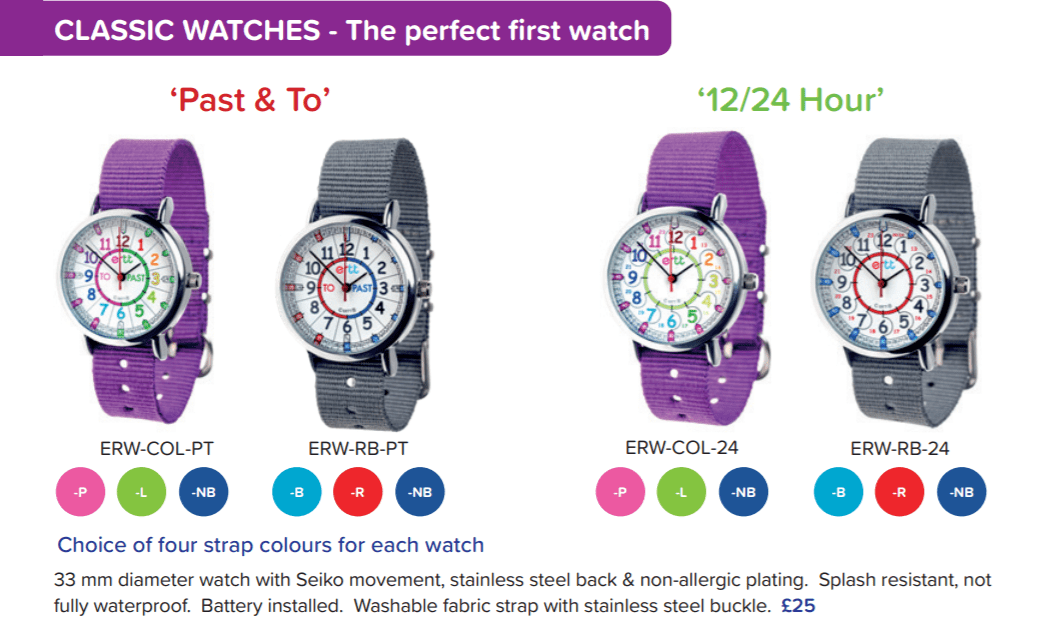
From around the time your child starts school, they will begin learning how to tell the time. Not only is this a key part of their primary education, but it also helps them to grasp the concept of time and gives them confidence and independence.
If your child or grandchild is starting school this year you are probably looking for a kids first watch or clock or to help them tell the time more easily and we’ve got just the products you need!
Download our latest catalogue to browse our range of tell the time wall clocks and watches, suitable for children from around 4 years of age. All of our products feature our simple time teaching system and can help give your child confidence as they learn this important skill.
Best kids first watch to learn to tell the time
The best watches to help children learn to tell time are those that make it easy for them to distinguish between the minutes past and to or the hours in a 12 and 24 hour format.
With our time teaching watches you can choose from our ‘Past & To’ method or our ‘12/24 Hour’ method:
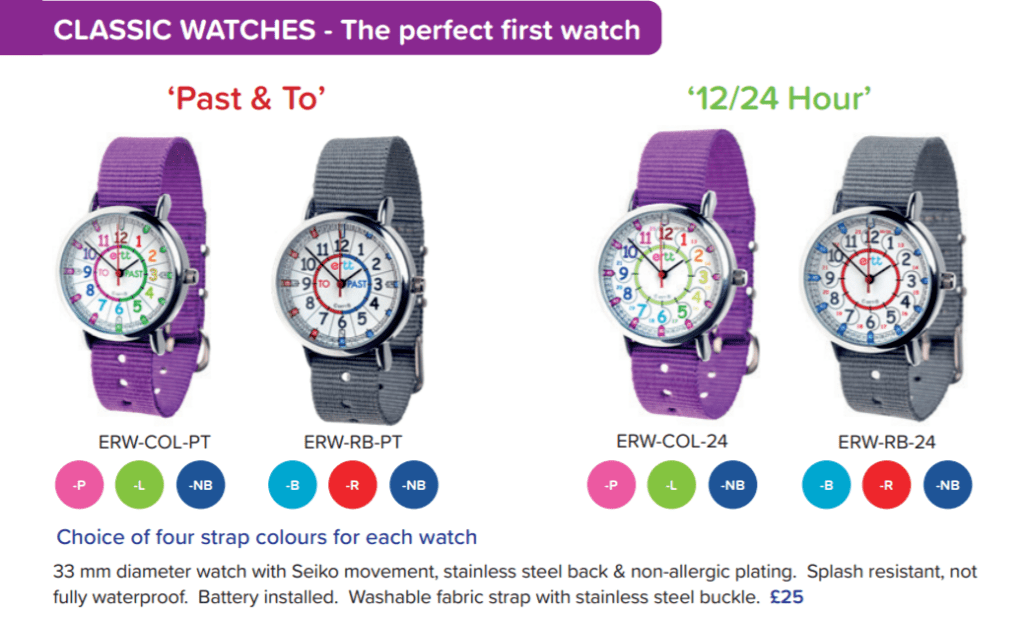
Choose from a rainbow or red and blue watch face and make a choice from our selection of strap colours and your kids first watch is ready to go.
For urban adventurers, or slightly older children who still need help telling the time but want something that looks a little cooler on their wrist, try our camo watches!

Again, you can choose from our ‘Past & To’ or ‘12/24 Hour’ time teaching method to suit your child’s needs and pick either a white or black face and colourful camo strap.
The time teaching shouldn’t stop just because you’re on holiday having fun, so upgrade your child’s time teaching watch to a waterproof one ready for summer splashing. These scratch resistant time teaching watches are waterproof to 50 metres and come with a blue or purple strap:
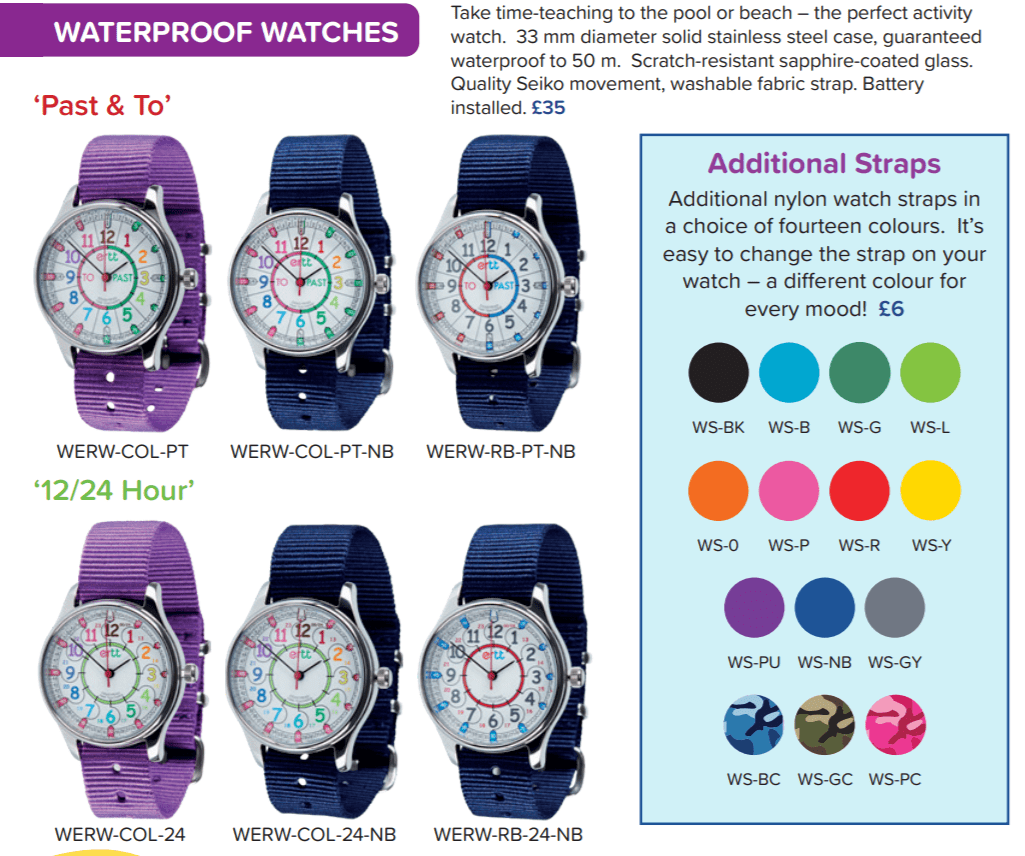
If your child is fixated on another colour, that’s no problem as we have a range of additional straps to choose from. With 14 different colours, there’s a strap for every mood!
Best wall clock to learn to tell the time
The best wall clocks to help children learn to tell the time are those that clearly display the numbers so they can be easily recognised from a distance. Our wall clocks feature a clear dial, brightly displayed numbers and of course a choice of our two simple time teaching methods ‘ Past & To’ and ‘12/24 Hour’.
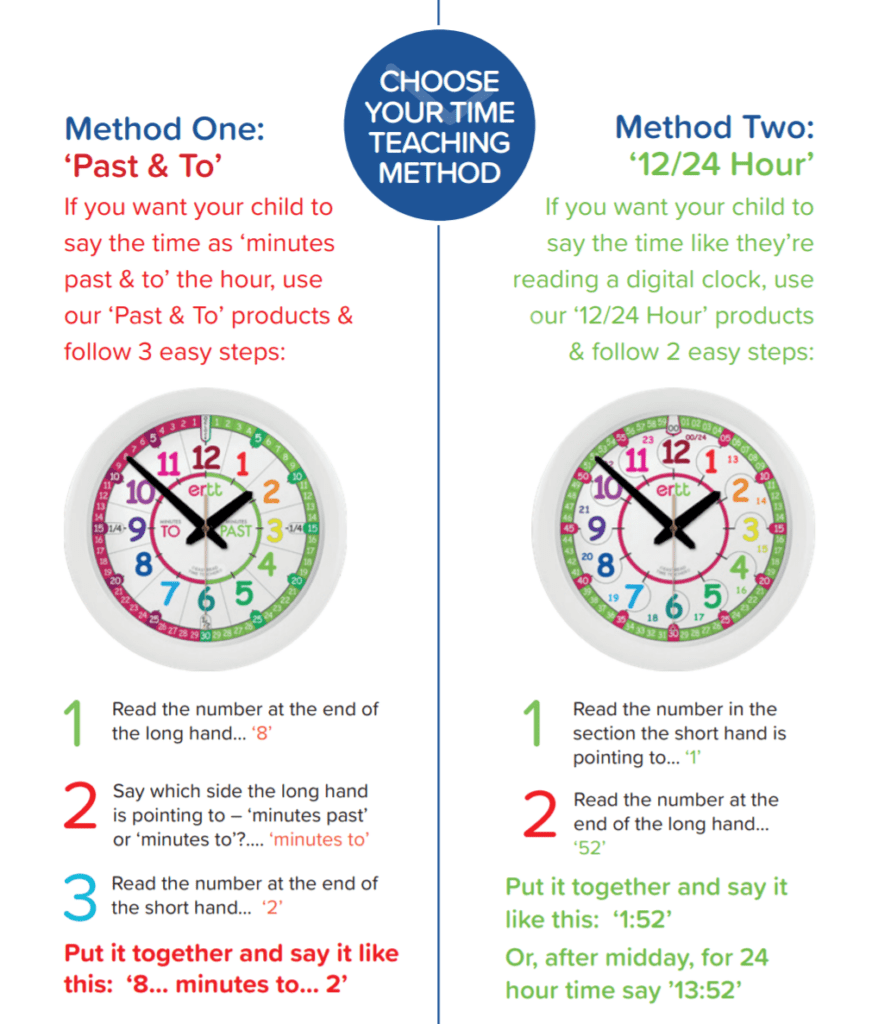
We also have a range of alarm clocks to help children know when it’s time for bed and more importantly, when it’s time to wake up 😀.
If you’re looking for the perfect kids first watch, or the best wall clock to help the whole family tell the time, download our latest brochure and get in touch with us if you have any questions.
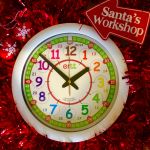
We often talk about the importance of learning outside the classroom and we’re big supporters of resources that help children to develop their maths skills at home. After a very disruptive 18 months, children need all the support they can get to help catch up on those lessons they have missed and with Christmas on the horizon (yes, it’s coming!), now is the perfect opportunity to research educational gifts such as our time teaching clocks.
Help the whole family stay on time
Whilst our wrist watches have always been popular festive presents due to the fact they can be bought for a child who is learning to tell the time at school, a teaching time clock is a gift that the whole family can benefit from. Hanging one of our clocks on the wall will not only support those children in your family who are learning to tell time, but they will also help younger children get used to the concept of time and looking at a clock, not to mention giving parents a clock face that can be easily read from a distance – priceless when all you get is a quick glance out of the corner of your eye to make sure the whole family is leaving the house on time!
Perfect in any room
A tell the time clock is a great accessory for your child’s bedroom but it can also be hung in the playroom, nursery, kitchen or hallway to ensure the whole family knows what time it is. Choose from our colourful rainbow face, striking red and blue face or plain white face to suit your home decor. Our wall clocks are 29 centimetres in diameter, made of durable plastic and take just one AA battery. They weigh 0.53kg, so are easy to hang and if you’re a multilingual household, you might be interested to know that our wall clocks are available in English, French and Spanish.
Simple time teaching methods
When you select the colour of your clock face you’ll also have a choice of our two simple time teaching systems:
- Past and To – a 3-step system that encourages children to read the number at the end of the long hand, point to either the ‘past’ or ‘to’ side of the clock face and read the number at the end of the short hand.
- 12 & 24 Hour – a 2-step system that encourages children to read the number at the end of the short hand, then the number at the end of the long hand and put them together.
With regular practice, using a teaching time clock featuring one of the above systems, reading the time will become something your child does naturally and confidently. Please click here to find out more about our time teaching systems and watch our quick videos to find the right system for your child.
A teaching time clock with no noisy ticking!
One of the things we often get asked by parents is whether our clocks are too noisy for the bedroom. The answer is no, because they feature silent hands and therefore will not disrupt your child’s sleep.
If a teaching time clock sounds like the perfect educational present for a child on your Christmas gift list, click here to browse our full range and buy now to avoid any last minute shopping panic!






















